
Trillium is a genus of about fifty flowering plant species in the family Melanthiaceae. Trillium species are native to temperate regions of North America and Asia, with the greatest diversity of species found in the southern Appalachian Mountains in the southeastern United States.

Trillium erectum, the red trillium, also known as wake robin, purple trillium, bethroot, or stinking benjamin, is a species of flowering plant in the family Melanthiaceae. The plant takes its common name "wake robin" by analogy with the European robin, which has a red breast heralding spring. Likewise Trillium erectum is a spring ephemeral plant whose life-cycle is synchronized with that of the forests in which it lives. It is native to the eastern United States and eastern Canada from northern Georgia to Quebec and New Brunswick.
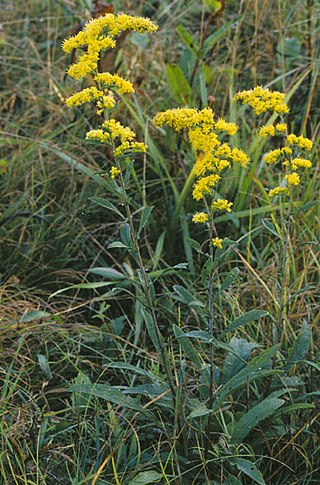
Goldenrod is a common name for many species of flowering plants in the sunflower family, Asteraceae, commonly in reference to the genus Solidago.

Arisaema is a large and diverse genus of the flowering plant family Araceae. The largest concentration of species is in China and Japan, with other species native to other parts of southern Asia as well as eastern and central Africa, Mexico and eastern North America. Asiatic species are often called cobra lilies, while western species are often called jack-in-the-pulpit; both names refer to the distinctive appearance of the flower, which consists of an erect central spadix rising from a spathe.
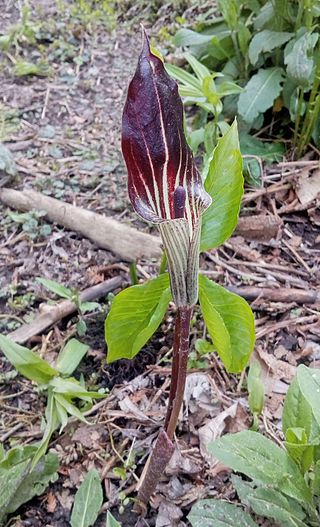
Arisaema triphyllum, the Jack-in-the-pulpit, is a species of flowering plant in the arum family Araceae. It is a member of the Arisaema triphyllum complex, a group of four or five closely related taxa in eastern North America. The specific name triphyllum means "three-leaved", a characteristic feature of the species, which is also referred to as Indian turnip, bog onion, and brown dragon.

Tiarella, the foamflowers, is a genus of flowering plants in the family Saxifragaceae. The generic name Tiarella means "little turban", which suggests the shape of the seed capsules. Worldwide there are seven species, one each in eastern Asia and western North America, plus five species in eastern North America. As of October 2022, the taxonomy of Tiarella in eastern North America is in flux.

Cardamine concatenata, the cutleaved toothwort, crow's toes, pepper root or purple-flowered toothwort, is a flowering plant in the family Brassicaceae. It is a perennial woodland wildflower native to eastern North America.

Cardamine diphylla is a flowering plant in the family Brassicaceae. It is a spring flowering woodland plant that is native to eastern North America.

Trillium pusillum is a species of flowering plant in the family Melanthiaceae known by the common names dwarf trillium, least trillium and dwarf wakerobin. It is native to the southeastern and south-central United States from Oklahoma to Maryland.

Stenanthium is a North American genus of flowering plants in the tribe Melanthieae of the family Melanthiaceae.
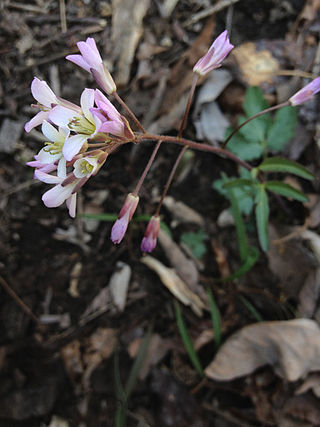
Cardamine angustata is a perennial forb native to the eastern United States, that produces white to pink or purple flowers in early spring.
Arisaema quinatum is a species of flowering plant in the arum family Araceae. It is a member of the Arisaema triphyllum complex, a group of closely related taxa in eastern North America. The specific name quinatum means "divided into five lobes", a reference to its characteristic leaves. It is commonly known as the southern Jack-in-the-pulpit but some refer to it as Preacher John.
Arisaema stewardsonii is a species of flowering plant in the arum family Araceae. It is a member of the Arisaema triphyllum complex, a group of closely related taxa in eastern North America. The specific name stewardsonii honors American botanist Stewardson Brown (1867–1921). It is commonly known as the bog Jack-in-the-pulpit. It is sometimes referred to as the swamp Jack-in-the-pulpit, not to be confused with Arisaema pusillum, which is also known by that name.
Arisaema acuminatum is a species of flowering plant in the arum family Araceae. It is a member of the Arisaema triphyllum complex, a group of closely related taxa in eastern North America. The specific name acuminatum means "with a long, narrow and pointed tip", which describes the shape of the spathe hood. The species is commonly known as the Florida Jack-in-the-pulpit.
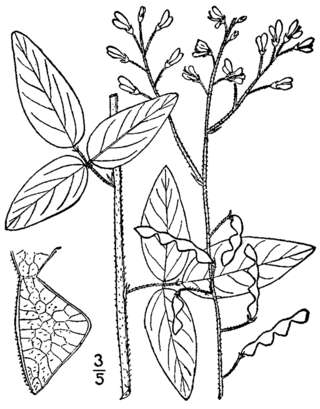
Desmodium glabellum is a perennial herb and wildflower in the pea family native to eastern and central North America. It grows in fields, woodland borders, and disturbed areas.

Symphyotrichum shortii, commonly called Short's aster, is a species of flowering plant in the family Asteraceae. It is native to North America, where it is primarily found in interior areas east of the Mississippi River. Its natural habitat is in thin rocky soils of woodlands and thickets often around limestone bluffs. It is common throughout much of its range, although it is generally restricted to intact natural communities.
Alan Stuart Weakley is an American botanist with expertise in the systematics, ecology, and conservation of the flora of the Southeastern United States. Weakley is the director of the UNC Herbarium at the North Carolina Botanical Garden and an adjunct associate professor at the University of North Carolina at Chapel Hill. He is the author of Flora of the Southern & Mid-Atlantic States, a manual covering the approximately 7000 vascular plants found in the Southeastern United States.

Hypericum fasciculatum, known as peelbark St. Johnswort or sandweed, is a species of flowering plant in the St. Johnswort family, Hypericaceae, native to the southeastern United States. It is found from eastern North Carolina, south to southern Florida, west to eastern Louisiana. Kew's Plants of the World Online database also notes that it occurs in Cuba, though Cuba is not listed in several other sources. It was first described in 1797 by Jean-Baptiste Lamarck.
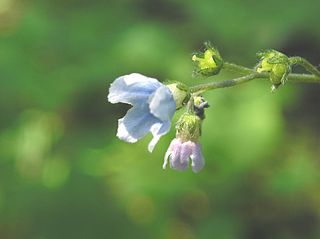
Andersonglossum is a small genus of North American plants in the borage family (Boraginaceae). They are commonly called American comfreys, wild comfreys, or hound's tongues.

Cardamine maxima is a species of flowering plant in the mustard family Brassicaceae.















